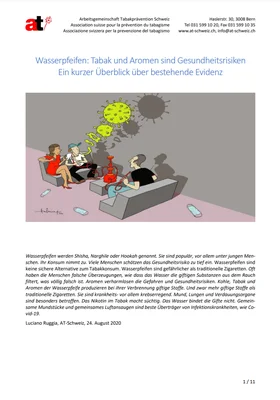Shisha and Water Pipe
Water pipe smoking is prevalent worldwide, especially among young adults. Although most users in western countries smoke water pipes intermittently, they often use other tobacco products concurrently. The spread of water pipe tobacco smoking is promoted by the use of sweetened and flavoured tobacco, social media that promotes water pipes, social acceptance, and misperceptions about the addictive potential and adverse health effects of water pipe smoking and presumed lack of addiction. Most users believe that water pipe tobacco smoking is less harmful than cigarette smoking, that the probability of addiction is low, and that quitting water pipe tobacco smoking is not difficult. However, the risk of initiation of cigarette smoking is higher among water pipe smokers than among never smokers, and the level of nicotine to which water pipe tobacco smokers are exposed can produce dependence with repeated exposure.
Health effects:
Although direct comparisons are difficult to interpret, compared with a single cigarette, a single session of water pipe typically results in greater exposure to carbon monoxide and particulate matter. Water pipe exposes smokers to significantly higher levels of heavier and more toxic polycyclic aromatic hydrocarbons, volatile organic chemicals, heavy metals, and cadmium, all of which have been associated with cardiorespiratory injury. Although the evidence for water pipe–attributable disease is not as robust as the evidence for cigarette smoking, a growing number of studies suggest that water pipe tobacco smoking is a potential risk factor for pulmonary and cardiovascular disease.
Quellen
Bhatnagar, Aruni; Whitsel, Laurie P.; Blaha, Michael J.; Huffman, Mark D.; Krishan-Sarin, Suchitra; Maa, John et al. (2019): New and Emerging Tobacco Products and the Nicotine Endgame: The Role of Robust Regulation and Comprehensive Tobacco Control and Prevention: A Presidential Advisory From the American Heart Association. In: Circulation 139 (19), e937-e958. DOI: 10.1161/CIR.0000000000000669.
Momenabadi V, Hossein Kaveh PhD M, Hashemi SY, Borhaninejad VR. Factors affecting hookah smoking trend in the society: a review article.Addict Health. 2016; 8:123–135. MedlineGoogle Scholar
Bahelah R, DiFranza JR, Fouad FM, Ward KD, Eissenberg T, Maziak W. Early symptoms of nicotine dependence among adolescent waterpipe smokers.Tob Control. 2016; 25:e127–e134. doi: 10.1136/tobaccocontrol-2015-052809CrossrefMedlineGoogle Scholar
Jacob P, Abu Raddaha AH, Dempsey D, Havel C, Peng M, Yu L, Benowitz NL. Nicotine, carbon monoxide, and carcinogen exposure after a single use of a water pipe. Cancer Epidemiol Biomarkers Prev. 2011; 20:2345–2353. doi: 10.1158/1055-9965.EPI-11-0545CrossrefMedlineGoogle Scholar
Rezk-Hanna M, Benowitz NL. Cardiovascular effects of hookah smoking: potential implications for cardiovascular risk [published online April 5, 2018]. Nicotine Tob Res. doi: 10.1093/ntr/nty065. https://academic.oup.com/ntr/advance-article-abstract/doi/10.1093/ntr/nty065/4961557?redirectedFrom=fulltext.Google Scholar
AT Switzerland, August 2020
Downloads

